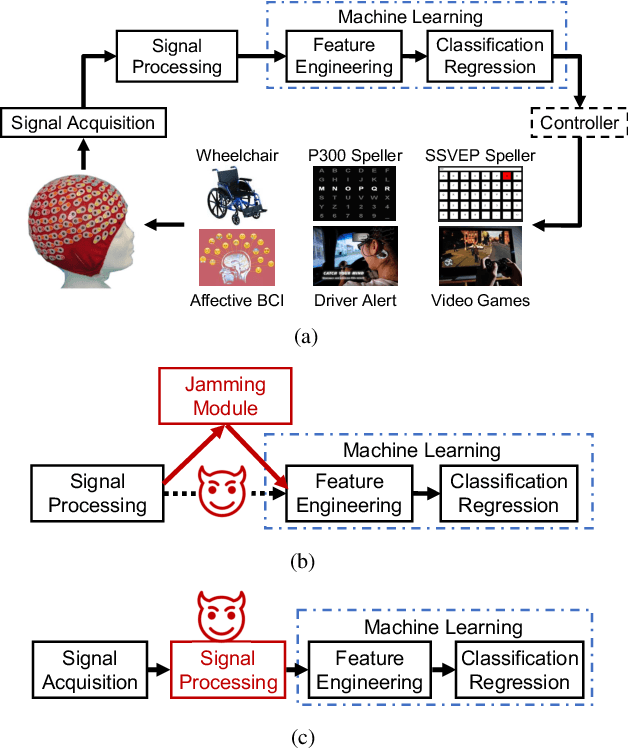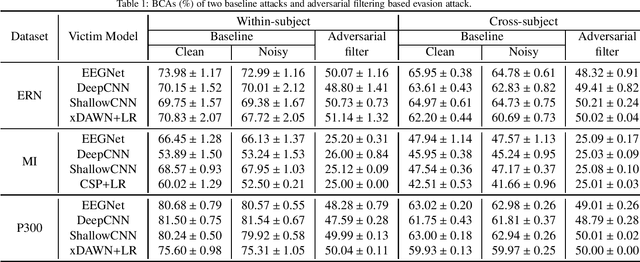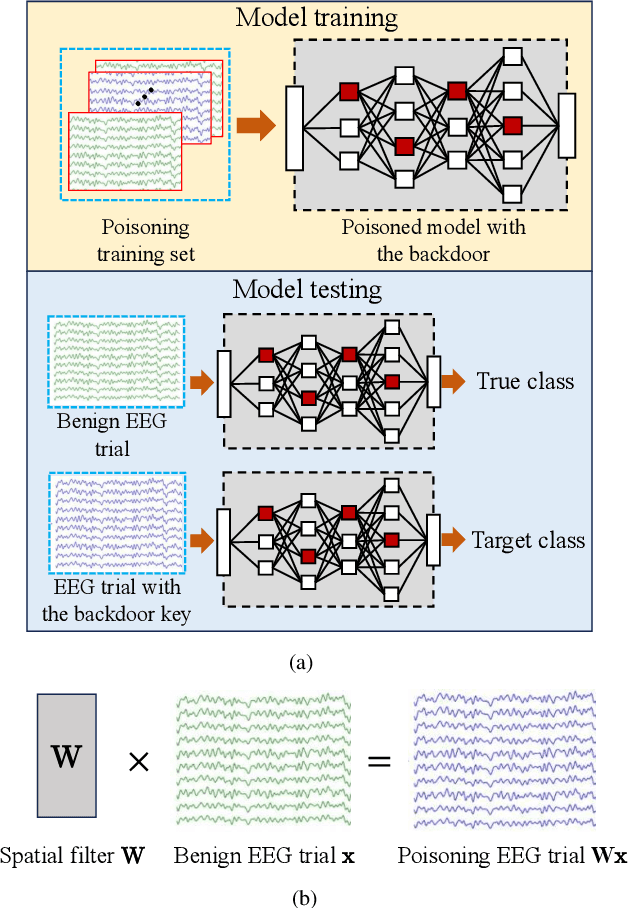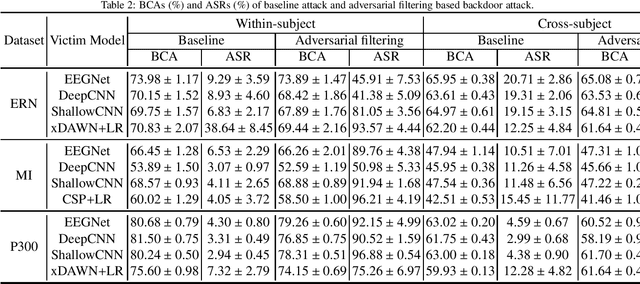Lubin Meng
Adversarial Filtering Based Evasion and Backdoor Attacks to EEG-Based Brain-Computer Interfaces
Dec 10, 2024



Abstract:A brain-computer interface (BCI) enables direct communication between the brain and an external device. Electroencephalogram (EEG) is a common input signal for BCIs, due to its convenience and low cost. Most research on EEG-based BCIs focuses on the accurate decoding of EEG signals, while ignoring their security. Recent studies have shown that machine learning models in BCIs are vulnerable to adversarial attacks. This paper proposes adversarial filtering based evasion and backdoor attacks to EEG-based BCIs, which are very easy to implement. Experiments on three datasets from different BCI paradigms demonstrated the effectiveness of our proposed attack approaches. To our knowledge, this is the first study on adversarial filtering for EEG-based BCIs, raising a new security concern and calling for more attention on the security of BCIs.
Federated Motor Imagery Classification for Privacy-Preserving Brain-Computer Interfaces
Dec 02, 2024



Abstract:Training an accurate classifier for EEG-based brain-computer interface (BCI) requires EEG data from a large number of users, whereas protecting their data privacy is a critical consideration. Federated learning (FL) is a promising solution to this challenge. This paper proposes Federated classification with local Batch-specific batch normalization and Sharpness-aware minimization (FedBS) for privacy protection in EEG-based motor imagery (MI) classification. FedBS utilizes local batch-specific batch normalization to reduce data discrepancies among different clients, and sharpness-aware minimization optimizer in local training to improve model generalization. Experiments on three public MI datasets using three popular deep learning models demonstrated that FedBS outperformed six state-of-the-art FL approaches. Remarkably, it also outperformed centralized training, which does not consider privacy protection at all. In summary, FedBS protects user EEG data privacy, enabling multiple BCI users to participate in large-scale machine learning model training, which in turn improves the BCI decoding accuracy.
Protecting Multiple Types of Privacy Simultaneously in EEG-based Brain-Computer Interfaces
Nov 29, 2024



Abstract:A brain-computer interface (BCI) enables direct communication between the brain and an external device. Electroencephalogram (EEG) is the preferred input signal in non-invasive BCIs, due to its convenience and low cost. EEG-based BCIs have been successfully used in many applications, such as neurological rehabilitation, text input, games, and so on. However, EEG signals inherently carry rich personal information, necessitating privacy protection. This paper demonstrates that multiple types of private information (user identity, gender, and BCI-experience) can be easily inferred from EEG data, imposing a serious privacy threat to BCIs. To address this issue, we design perturbations to convert the original EEG data into privacy-protected EEG data, which conceal the private information while maintaining the primary BCI task performance. Experimental results demonstrated that the privacy-protected EEG data can significantly reduce the classification accuracy of user identity, gender and BCI-experience, but almost do not affect at all the classification accuracy of the primary BCI task, enabling user privacy protection in EEG-based BCIs.
EEG-Based Brain-Computer Interfaces Are Vulnerable to Backdoor Attacks
Oct 30, 2020



Abstract:Research and development of electroencephalogram (EEG) based brain-computer interfaces (BCIs) have advanced rapidly, partly due to the wide adoption of sophisticated machine learning approaches for decoding the EEG signals. However, recent studies have shown that machine learning algorithms are vulnerable to adversarial attacks, e.g., the attacker can add tiny adversarial perturbations to a test sample to fool the model, or poison the training data to insert a secret backdoor. Previous research has shown that adversarial attacks are also possible for EEG-based BCIs. However, only adversarial perturbations have been considered, and the approaches are theoretically sound but very difficult to implement in practice. This article proposes to use narrow period pulse for poisoning attack of EEG-based BCIs, which is more feasible in practice and has never been considered before. One can create dangerous backdoors in the machine learning model by injecting poisoning samples into the training set. Test samples with the backdoor key will then be classified into the target class specified by the attacker. What most distinguishes our approach from previous ones is that the backdoor key does not need to be synchronized with the EEG trials, making it very easy to implement. The effectiveness and robustness of the backdoor attack approach is demonstrated, highlighting a critical security concern for EEG-based BCIs.
White-Box Target Attack for EEG-Based BCI Regression Problems
Nov 07, 2019



Abstract:Machine learning has achieved great success in many applications, including electroencephalogram (EEG) based brain-computer interfaces (BCIs). Unfortunately, many machine learning models are vulnerable to adversarial examples, which are crafted by adding deliberately designed perturbations to the original inputs. Many adversarial attack approaches for classification problems have been proposed, but few have considered target adversarial attacks for regression problems. This paper proposes two such approaches. More specifically, we consider white-box target attacks for regression problems, where we know all information about the regression model to be attacked, and want to design small perturbations to change the regression output by a pre-determined amount. Experiments on two BCI regression problems verified that both approaches are effective. Moreover, adversarial examples generated from both approaches are also transferable, which means that we can use adversarial examples generated from one known regression model to attack an unknown regression model, i.e., to perform black-box attacks. To our knowledge, this is the first study on adversarial attacks for EEG-based BCI regression problems, which calls for more attention on the security of BCI systems.
Towards Real-time Eyeblink Detection in The Wild:Dataset,Theory and Practices
Feb 21, 2019



Abstract:Effective and real-time eyeblink detection is of wide-range applications, such as deception detection, drive fatigue detection, face anti-spoofing, etc. Although numerous of efforts have already been paid, most of them focus on addressing the eyeblink detection problem under the constrained indoor conditions with the relative consistent subject and environment setup. Nevertheless, towards the practical applications eyeblink detection in the wild is more required, and of greater challenges. However, to our knowledge this has not been well studied before. In this paper, we shed the light to this research topic. A labelled eyeblink in the wild dataset (i.e., HUST-LEBW) of 673 eyeblink video samples (i.e., 381 positives, and 292 negatives) is first established by us. These samples are captured from the unconstrained movies, with the dramatic variation on human attribute, human pose, illumination condition, imaging configuration, etc. Then, we formulate eyeblink detection task as a spatial-temporal pattern recognition problem. After locating and tracking human eye using SeetaFace engine and KCF tracker respectively, a modified LSTM model able to capture the multi-scale temporal information is proposed to execute eyeblink verification. A feature extraction approach that reveals appearance and motion characteristics simultaneously is also proposed. The experiments on HUST-LEBW reveal the superiority and efficiency of our approach. It also verifies that, the existing eyeblink detection methods cannot achieve satisfactory performance in the wild.
 Add to Chrome
Add to Chrome Add to Firefox
Add to Firefox Add to Edge
Add to Edge